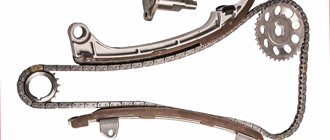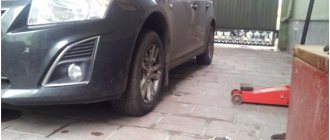Aluminum valve cover
It is currently almost impossible to buy an aluminum valve cover in offline stores. Therefore, you can only find it on the Internet - in online stores, message boards, or directly in China. For example, here
The lid was delivered in a cardboard box
Inside there is foam and plastic packaging
Inside there is a small bag with a gasket and a new crankcase ventilation valve
Oil from under the valve cover
The cause of any leak of lubricating fluid, no matter where the connection between engine elements occurs, is mainly due to poor crankcase ventilation. This could be not only a valve cover, but also a fuel pump, distributor, and more.
During operation, some of the exhaust gases escape from any piston, and through its seal they leak into the engine crankcase. If the power unit is new, then the amount of leaking gases will be minimal. But with good mileage, a lot of exhaust gases accumulate in the crankcase, and eventually excess pressure forms and the valve cover leaks. To reduce it, new cars have an additional ventilation system designed specifically for the engine crankcase.
Aluminum Valve Cover Gasket
The gasket has a T-shaped profile and “rounds” for bolts. Therefore, the rubber rings that were installed on the plastic cover are not needed here.
First of all, I ordered another such gasket in reserve, since you can’t buy it in our regular stores. I ordered it here
There are several of them, you need to take the blue one.
I hope I won’t need it, but I need to have it in stock. After all, you never know for whatever reason you will have to remove the cover in the future. For example, as in this case, when the coolant began to leak.
PCV valve for aluminum valve cover
There are some nuances with the crankcase ventilation valve. The fact is that I have not yet seen the normally functioning valves that come with the lid.
It works very slowly and freezes periodically. This disrupts the operation of the crankcase ventilation system and idle speed, and also leads to a freezing speed when shifting gears.
And that's only half the trouble. The fact is that simply installing an old valve from a plastic cover into an aluminum one will not work. They have different carvings. On the original valve it is smaller
Some managed to screw in the old valve by force. But there is a high chance of breaking the valve.
Personally, I have installed a new valve for now. But for normal operation I had to reset the adaptations.
In general, if after replacement your car starts having problems with speed, then reset the adaptations. If this does not help, then either screw the valve in by force, or cut the thread, or screw the valve through an adapter (any turner can make it).
In my case, everything is much simpler, since I have an old-style lid.
Seals (oil seals)
The gasket that seals the stem with the cap is called a seal and consists of the following components:
- The cover of the sealing device, which is a sleeve that compresses the packing, is stuffed into the stuffing box.
- Gland, a type of sleeve that compresses the packing into the stuffing chamber.
- Filling chamber, a chamber in which packaging is compacted.
- Packaging available in various materials such as PTFE, elastomers, fiber materials, etc.
- The rear seat is located inside the cover. The back seat provides a seal between the stem and the bonnet and prevents system pressure from building up against the valve seal when the valve is fully open. Rear seats are often used in latches and latches.
- Valve packaging must be properly designed and manufactured to minimize potential damage to the stem and minimize the risk of fluid leaks. On the other hand, it must be taken into account that packing that is too tight can affect the stem.
Drive unit
A manually operated valve typically has a hand wheel that can be rotated clockwise or counterclockwise to open and/or close the valve (typical of gate and ball valves). Ball, plug or butterfly valves are operated by a lever (manual quarter turn valves). In the following cases, it is not possible or recommended to use manual valves:
- Large valves operating at high pressures
- Valves that need to be controlled from a remote location
- Valves which require, due to the nature of the process, very rapid opening or closing.
In all these cases, a valve actuator is required. The actuator produces linear and rotary motion capable of opening or closing the valve (the actual motion depends, of course, on the type of valve, linear or quarter turn). The main types of valve actuators are:
- Hydraulic drive
- Electric drive
- Pneumatic actuators (pneumatic control valves often use this type)
- Actuators
- Pneumohydraulic drive
- Solenoid drive
Rotork and Auma actuators have the largest market share in the petrochemical industry.
The nuances of an aluminum valve cover
The lid itself also has pitfalls
The first thing you need to know is that plastic covers have several modifications. And the most important difference is the crankcase ventilation fitting. Here he is
It is available on old-style covers. But on the new ones it was abolished.
Therefore, check in advance which cover you have. If there is no fitting, then ask the seller to plug it (most offer this service).
Or turn it off yourself. There are a lot of options - starting from a hose with a bolt and ending with cutting a thread and screwing a plug into it.
The problems with other hoses and fittings are much less. Simply shorten the hose that came out of the center of your valve cover and connect it to the fitting near the PCV valve on the new cover.
Also be sure to check all separator screws
They must be tightened tightly. If they come loose due to vibration and fall into the engine, it won't be very good.
And be sure to check the flatness of the lid itself and remove any paint deposits around the perimeter.
Only after this can you begin installing it on the car.
All the nuances, as well as the pros and cons of this cover are described in detail and shown here
Aluminum Valve Cover Installation
The process of dismantling the plastic cover is absolutely not complicated and is described in detail on the page Replacing the valve cover gasket
Therefore, I will not dwell on this in detail here.
In short:
Disconnect all crankcase ventilation hoses from the cover
Disconnect the connector from the DPRV
Unscrew the 15 bolts securing the cover.
It is not necessary to unscrew the spark plugs. Only if they are in oil, then it is worth unscrewing and wiping. Spark plug wires can be easily removed from oil using a contact protector.
Remove the cover.
We have this look
Insert the gasket into the cover
Carefully wipe the perimeter of the block head from oil and degrease
Apply a little sealant to these places
By and large, if there is no sealant, then you can do without it. But it’s still better to be safe.
Holding the gasket with your fingers, turn the cover over and install it on the engine.
We tighten the bolts.
How to change a valve gasket
As described, the most common cause of oil leakage is a leaky gasket.
The procedure is performed on a cold engine. Its replacement is carried out in the following sequence:
- Place the car on a flat surface and open the hood.
- After removing the filter cover, unscrew all bolts. The cover is removed from the cylinder head.
- Remove the worn gasket. All element connections must be cleaned of previously applied sealant. Degrease the parts.
- Treat the new part with a layer of sealant.
- Reassemble everything in reverse order.
- All that remains is to wipe the head and turn on the motor.
If the leak is detected again, it is obvious that the selected gasket and/or sealant is of poor quality. Or the parts were reassembled in the wrong order.
Aluminum Valve Cover Tightening Torque
This is a rather important nuance. The tightening torque for the plastic cover is 10 Nm. But you shouldn’t pull the aluminum cover like that. Much less effort is needed here for several reasons:










